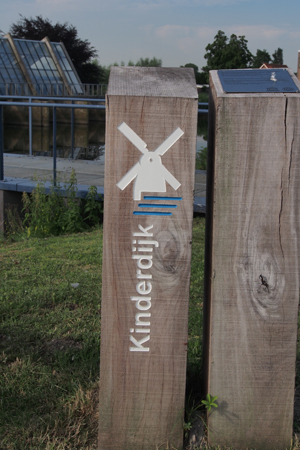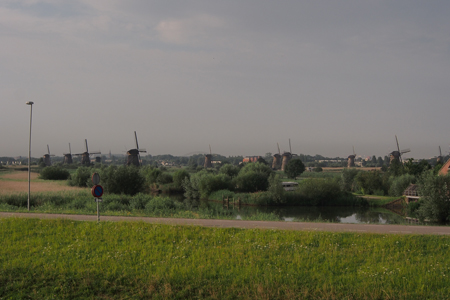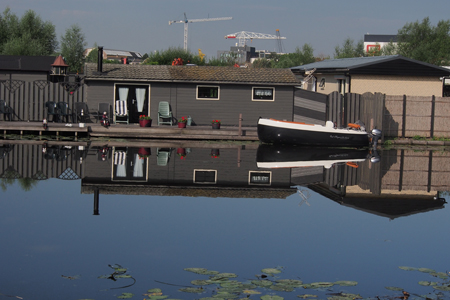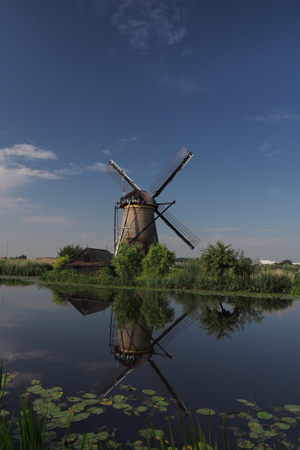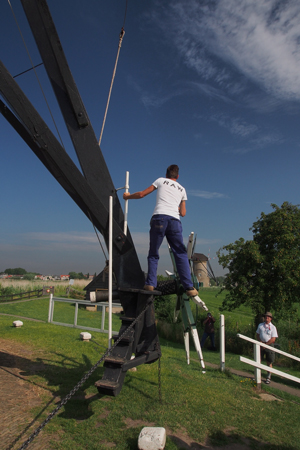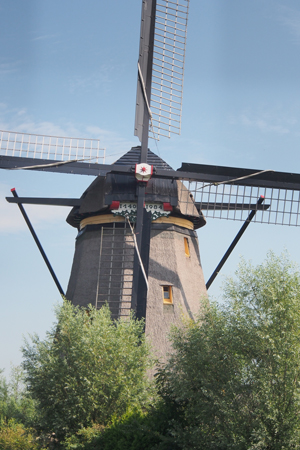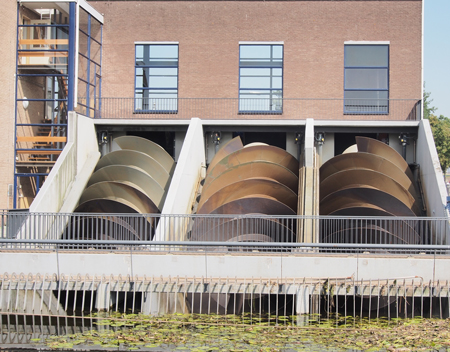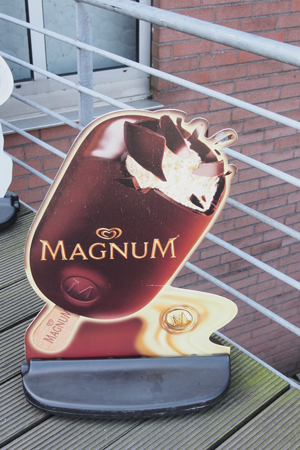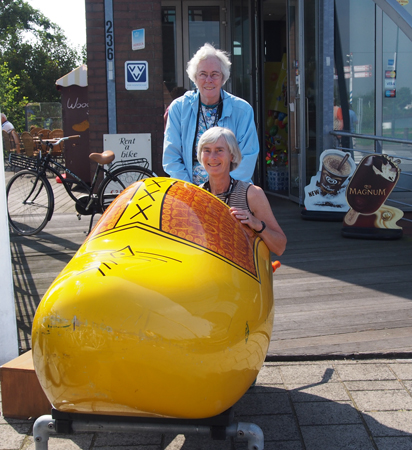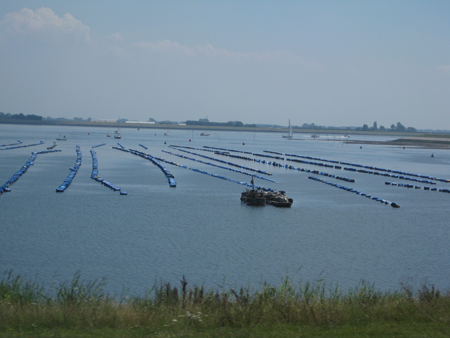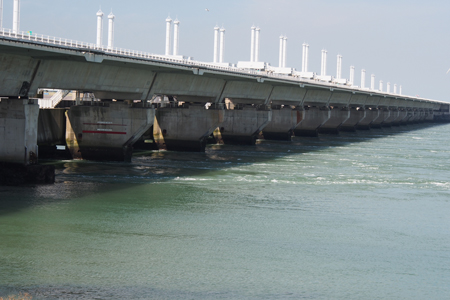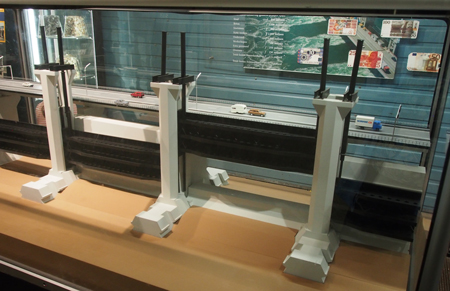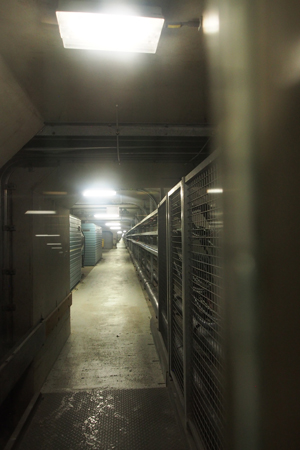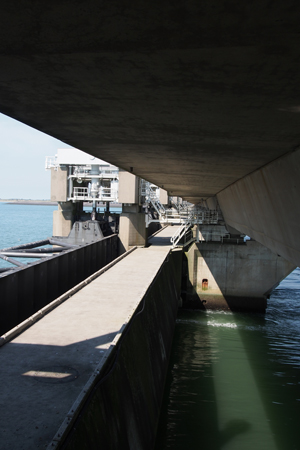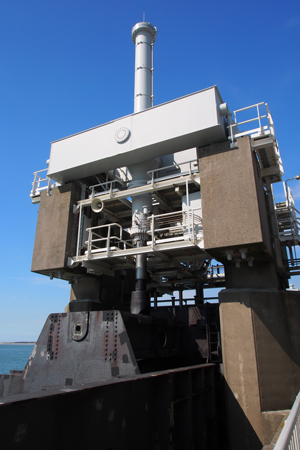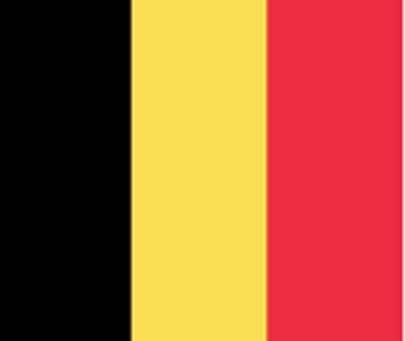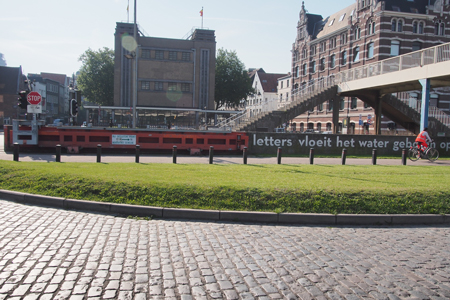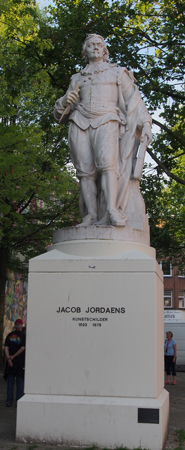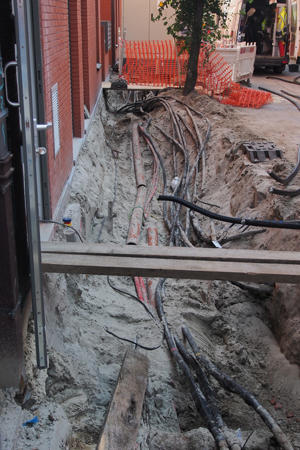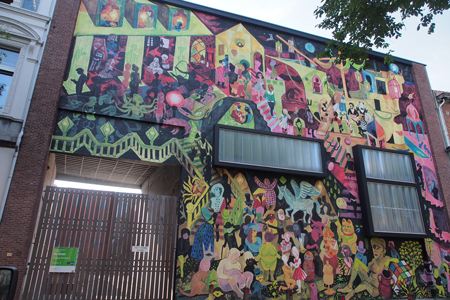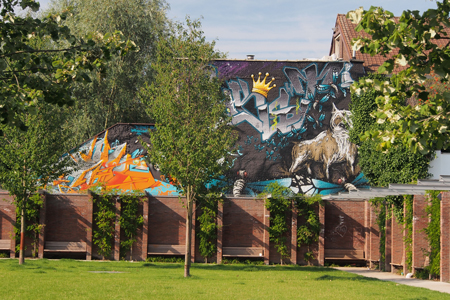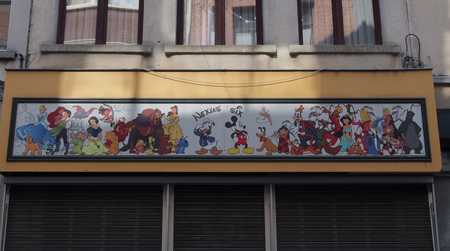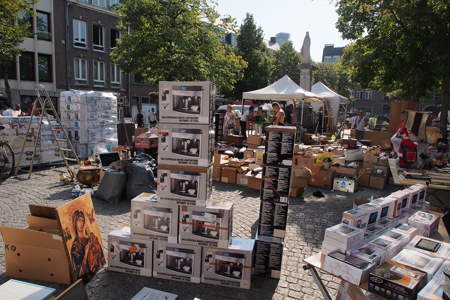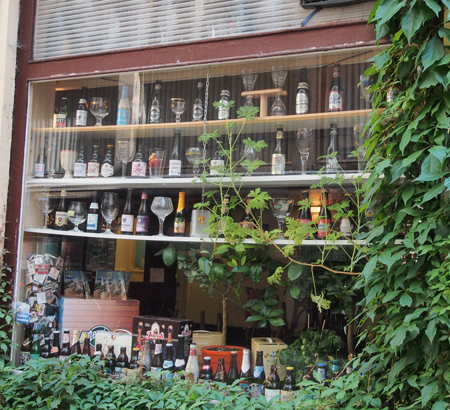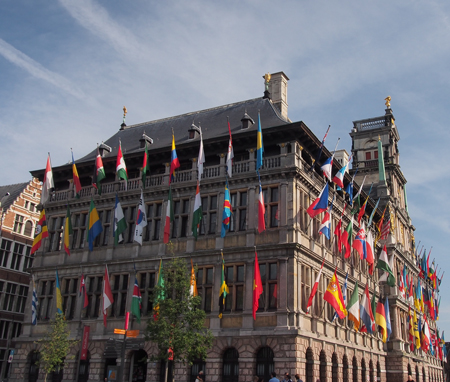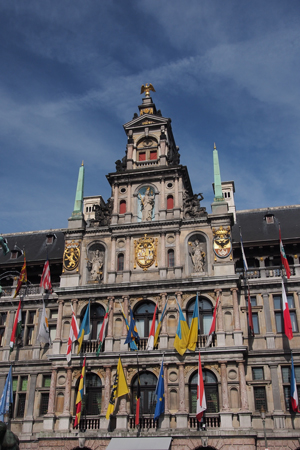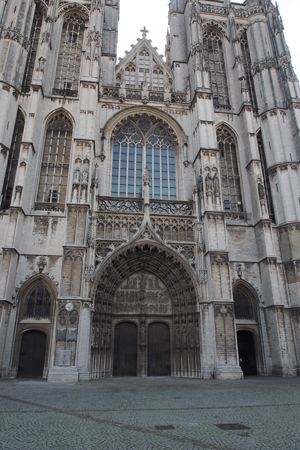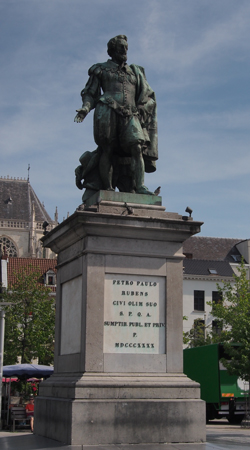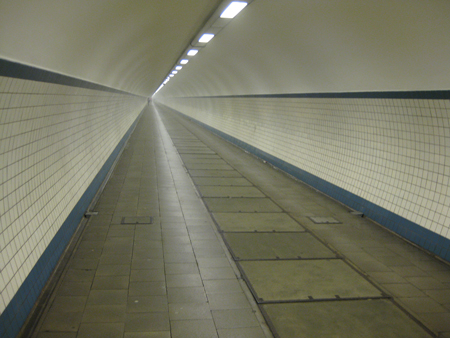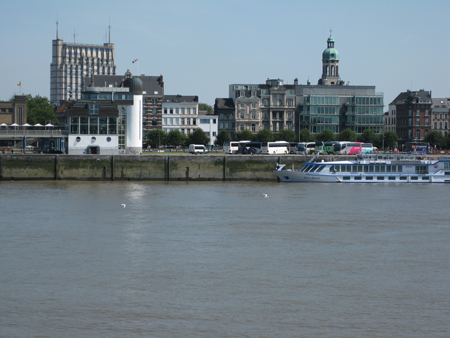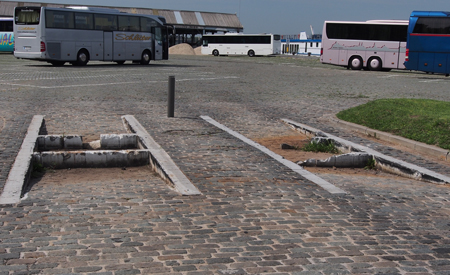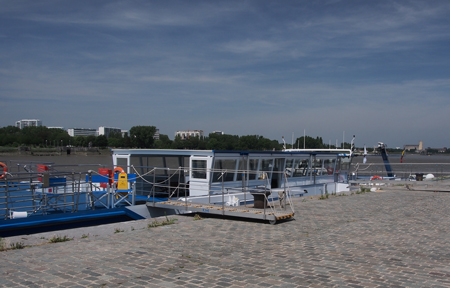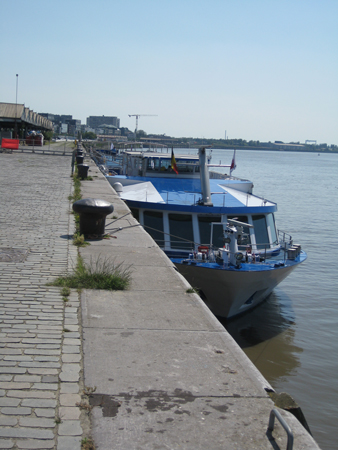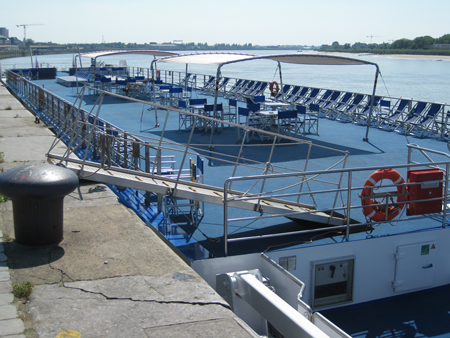Thurs., 7/17/14 – Kinderdijk and Willemstad, Netherlands
This morning we docked at Kinderdijk, a UNESCO World Heritage Site, with 19 working windmills that empty water from the town and agriculture fields that are three to nine feet below sea level into the Lek or Nord Rivers. At one time the Netherlands had around 10,000 windmills and now there are about 1,000. The 19 windmills in Kinderdijk have to be lived in, maintained, and blades rotated 60,000 times a year to earn 250 Euros a month and live in the mill for free. This is only a part-time job; all of the residents have full-time, real jobs.
We visited one of the 18th c. working windmills. The owner showed us how the top turret with the windmill blades is rotated into the wind by hand. A chain is attached to a stone cleat and the chain is pulled tight using a hand crank. The process is repeated several times. The blades today were not moving because there was no wind and the sail canvas was rolled or furled up on the blades. In a wind the owner has to climb the blade and position the canvas over the wooden slats of the blade. We walked up three stories inside the mill to look at how a family would have lived inside. There was not a lot of room around all of the gears and moving parts inside.
A World Heritage Site
Windmills of Kinderdijk
House by the canal - a reflection
Windmill and reflection
Operating the windmill by hand
How it works
Canal boat coming to give us a ride
We took a canal boat ride to get a feel for the drainage system necessary to maintain the reclaimed land. The process can be reversed and water put back into the fields should there be a drought. The older windmills in the UNESCO site are built with stone and are heavy enough to sink into the moist ground. The newer mills are made of lighter weight thatch.
The diesel pump house, with three huge Archimedes screws, is owned by the Schmidt family. One of the three brothers is now a large ship builder, another runs a canal dredging company that has worked around the world, and the third brother runs a ship salvage business and was the company that eventually raised and towed the Costa Concordia Italian ship that sank off the coast of Italy in 2012. This is a rather prosperous family!
The date reads 1440 - 1984
Archimedes screws
Yum!
Us in a wooden shoe
Our ship sailed on to Williamstad, which is a cute, very small town built inside a star-shaped fortress. We were not able to set foot inside Williamstad because we were taking the optional excursion to tour the Delta Works, a project designed to hold the North Sea from flooding into the delta of Zeeland province of the Netherlands.
After an hour-long bus trip, we arrived at the Delta Works museum and watched a movie on the construction of the barrier to the North Sea and then had a little time to view the exhibits.
We then rode a train pulled by a tractor over to the Delta Works, a man-made barrier six kilometers long of concrete and steel that closed off the North Sea from the delta waters of the Rhine, Meuse, and Scheldt Rivers. Our tour guide explained the building and positioning of the 65 piers on the prepared seabed. The 62 huge gates, 12 to 60 meters in height, can be closed in 75 seconds with the push of one button. The gates are only closed when storm surges reach a certain height. In the meantime the center section has openings for fish to go back and forth. We watched a seal go through and out into the North Sea.
The Delta Works Project was a magnificent engineering success. They hope it will protect them for 200 more years.
Mussel farm
Delta Works at the Rhine-Meuse-Scheldt River deltas
Model showing the highway passing over the piers
Down under the water
Storm surge barriers
Hoists to raise and lower the barriers
Seal who just swam through the open barrier
Storm surge barriers
Fri., 7/18/14 – Antwerp, Belgium
This morning we were docked in Antwerp along the quay where immigrants once boarded ships to America. We started our walk with some information on Belgium. The country is a Constitutional Monarchy. The Queen here also abdicated in favor of her son who became King Philip with his wife Queen Matilda. 80% of the world’s uncut diamonds pass through Antwerp. Antwerp and Belgium are known for chocolates, 1,000 kinds of beer - each brand of beer is served in a different style glass, fashion design, lace, Belgian “wafels,” fries not to be called French that are served with mayonnaise (and called frites), and comic books.
We started our walk between two of the three iron hangars or sheds where immigrants were processed and loaded onto ships. We walked through an opening in a three-foot high floodwall that can be closed as a floodgate if necessary. We briefly looked at a statue of Jacob Jordaens, a Flemish painter.
Flag of Belgium
License plate of Belgium
Antwerp dock
Barrier which can be used as a flood gate
Iron hangars or sheds where immigrants were once processed and loaded onto ships
Jacob Jordaens
Utility work in progress
Wall murals
Public graffiti park
Comic strip murals
Comic strip murals
Friday Market
There is a legend about a local Boogieman that could change height from a baby to a very large man and back to small again. A statue of Mary was said to chase the Boogieman away, so there are many statues of Mary on the facades of old houses. When the city decided that streetlights were needed in the city streets, people were charged to have one installed unless it was attached to a Mary. We saw several elaborate Marys with a lantern attached.
Statue of Mary on the corner of a building
Belgian beers and their glasses
The city hall dominates the main square. It is decked out with the flag of every country that has an embassy in Antwerp. There is no US flag because our embassy is in Brussels. The ground floor has iron or wood doors where merchants had their markets. Several Guild houses with symbols on top representing their trade lined another side of the square.
We walked to the impressive Cathedral of Our Lady. It was built between the 14th and 16th centuries. The steeple is 440-feet high and it has a 47-bell carillon that plays throughout the day. Inside are three Rubens paintings so a fee is charge to see the inside. We did not go in. And last, we walked to the Groenplaats, the Green Place, that had a statue of Pieter Paul Rubens by the local sculptor Willem Geefs.
City Hall
City Hall
Guild Halls
Cathedral of Our Lady
Cathedral of Our Lady
Peter Paul Rubens
After lunch Gale went out to investigate the pedestrian and bike tunnel under the river. At each end is a gate house with escalators and a large, 40-person elevator. People and bike riders share the elevator. There are two stories of escalators. The tunnel is 100-feet below the surface and is over a half kilometer long. I walked to the other side to take pictures of our boat and the skyline of Antwerp. The tunnel was a new experience. It was built in 1933, bombed during WWII, and rebuilt. It is well used.
Elevator to the tunnel
Under river tunnel
Antwerp from the far bank of the river
Parking lot barricades
To keep people from illegally parking in the bus lot, they have dug axle-width depressions with barriers that a bus can clear but a car cannot.
The tide on the Scheldt is about 18-feet. We left the ship at high tide and the gangplank was off of the lobby as usual - you had to walk down to the pier. Later in the afternoon (4 PM) you could no longer see our ship. The river was down so far we walked down to get on board on the upper sun deck!
River Melody at 9 AM
River Melody at 11:30 AM
River Melody at 2 PM
River Melody at 4 PM
River Melody at 4 PM
Our last briefing before our last dinner on the River Melody was a lot of fun. Our three tour directors said their goodbyes to us. Rebecca sang the Irish prayer or blessing:
May the road rise up to meet you.
May the wind always be at your back.
May the sun shine warm upon your face,
And rains fall soft upon your fields.
And until we meet again,
May God hold you in the palm of His hand.Johannes read a poem the three of them had written about our trip, and Steven invited any of us who were interested to join him after dinner for a free excursion to the Antwerp red-light district. Our tour guide several years ago took us to the Amsterdam red-light district so we stayed on board and finished packing.
| Return to Top | Return to Itinerary | Return to Trips page to view other trips | Return to Dreamcatcher Home Page |
